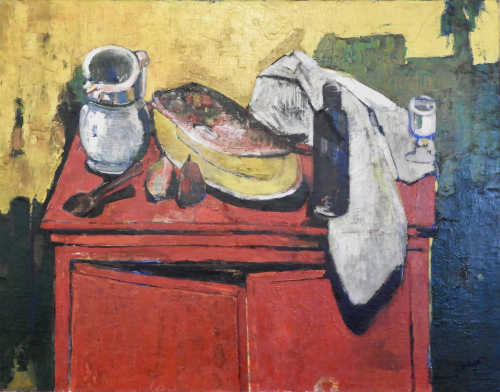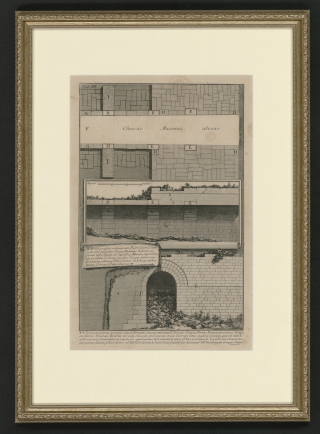The Visual Arts Collection’s holdings in European art continue to grow and evolve. Our European collection includes works by Alfred Van Nest, Alvar Suñol, Barbara Hepworth, Giovanni Battista Piranesi, Karel Appel, Pierre Auguste Renoir, Sir Muirhead Bone, and Pierre Bonnard.

In 2017, the McGill Visual Arts Collection acquired this fascinating double-sided sketch by Pierre-Auguste Renoir (1841-1919). This French artist known for pioneering the impressionist style and celebrated for his representations of beauty and feminine sensuality. One side of the artwork depicts a vertical drawing of a standing female nude. The other side depicts three nudes –Apollo and Daphne within a circle and a square, and cupid to their right. The mythological figures represented in this second drawing were a popular neoclassical motif in Europe throughout the nineteenth and early twentieth centuries. Numerous pages from this sketchbook, which date from Renoir’s teenage years, are held at the National Gallery of Canada in Ottawa.

Bernard de Hoog (1866-1943) was a Dutch painter from Amsterdam whose work was influenced by the Hague School, a group of artists that heavily relied on realism and the use of somber colours to depict scenes of everyday life in the Netherlands. Mostly known as a painter of interiors and simple country living, De Hoog received his artistic training at a drawing academy and, later, as a pupil of Jan van Essen (1854-1936). He received a subsidy from the Dutch Queen for two years, was collected and exhibited everywhere in his home country, and saw his paintings exported around the world, notably in the United Kingdom, the United States, and Canada.
Woman and Children, Dutch Family Scene, emulates the interior scenes often presented in paintings of the Dutch Golden Age. Typical of De Hoog’s style, it presents a mother and her children in a modest domestic setting, bathing in soft and warm windowlight.

Bernard Lorjou (1908-1986) was a French expressionist artist whose body of work is remarkable for its evocative capacity, thematic diversity, and vibrant colours. While he initially achieved success as a silk designer in Paris and experimented with various media such as sculpture, engraving, lithography, and stained-glass, Lorjou's true passion was always painting. His reputation as a painter gained momentum during the later part of his career. A founding member of L'homme témoin, a group of young artists that sought to defend figurative painting at the height of the abstract movement, he is best recognized for his monumental representations of sociopolitical events and still lifes. Le Buffet Rouge is a prime example of the latter.

Giovanni Battista Piranesi (1720-1778) was an Italian architect, art theorist, and artist widely recognized for his drawings of Roman structures and fantastical prison interiors. His precise yet original designs influenced many artists and literary figures during and beyond his lifetime. His artistic output was dispersed and popularised through the sale of prints to tourists who visited his workshop.
Cloaca Maxima, dated 1748, is a representation of one of the world’s earliest sewage systems, initially built around 600 B.C.E. by the fifth king of Rome, Lucius Tarquinius Priscus. Piranesi produced multiple drawings of this major construction. A different view of it, also by Piranesi, is currently on display in the Visible Storage Gallery.

Barbara Hepworth (1903-1975) was a British abstract sculptor from Wakefield, England. She studied at Leeds School of Art, alongside Henry Moore (1898-1986), as well as at the Royal College of Art, in London. Today, Hepworth is recognized as one of the most influential sculptors of her time, one of the first English abstract sculptors to venture into abstracts work, and one of the few women artists of the early twentieth century to have achieved international prominence. Her work is notably displayed at the United Nations headquarters in New York, at the University of Oxford’s St Catherine College, and at the Tate Gallery of London.
Square Forms and Circles is the first of seven nearly-identical casts, all of them sold except for one which was retained by Hepworth. It is composed of six right-angled quadrilaterals, two of them presenting circular-shaped depressions or incisions. The bronze was selectively patinated green and given a worn-like texture by the artist. Square Forms and Circles is exhibited in the James Sculpture Garden.